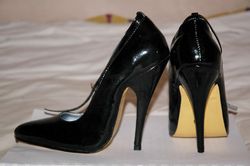Court shoe
Court shoes (British English) or pumps (American English) are shoes with usually no fastening and a low cut front. However, some have ankle straps. They are usually worn by women now, but are still traditional menswear in some formal situations, when they are sometimes called opera slippers or patent pumps.
As women's shoes
Court shoes for women are usually heeled. The heel and toe can be any shape as dictated by the fashion of the time. In the UK, in 2007 a closed toe and wide (non-stiletto) heel were worn by the very fashion conscious, but most still wore stilettos of mainly 'kitten' height to medium height. Outside the fashion trade in the UK, the term "pumps" would normally imply flat or low heel dancing or ballerina pumps, or even rubber soled canvas plimsoll shoes.
The shoes can be made from any material, but traditional patent leather is popular. Court shoes are mostly worn with a suit or a uniform, but are also worn with formal and informal dresses, skirts, trousers, and jeans. White stiletto heeled court shoes are the standard attire with swimsuits in beauty contests.
Court shoes are also part of the costume of ballroom dancers. They are made of satin, usually tan, though other colors are made as well, and worn on both the competition and practice floors.
As men's shoes
In the British Regency period, during the day men wore dress boots, and boots or court shoes by night, which accompanied silk knee-high stockings and breeches. The shoes originally had silver buckles, but these were removed by the influence of Beau Brummell, and a square grosgrain bow was added. By Victorian times, evening footwear was the court shoe when there would be dancing or music (hence the name opera shoe or opera slipper), and patent leather dress boots otherwise. Court shoes remained as standard for wearing with full dress until the 1930s. At that time, the dress boot was also going out of fashion, as laced shoes began to be worn at all times.
Even though it now survives in much the same form as it was at the start of the nineteenth century (though it is occasionally now worn with plain, not patent, calf), the court shoe has been largely displaced by Oxfords, perhaps because of an effeminate image and the declining use of white tie. It remains acceptable (though rare) with black tie, and, since formal boots are now hardly ever worn, court shoes are standard with white, the only remaining common use. They can be also seen today on British High Court Judges, and are still preferred with formalwear by many leaders of style.
The construction of the shoes is simple, using a wholecut leather top lined with cloth (not leather). The sole either glued onto the bottom, common on cheaper models, or sewn, as on more expensive bespoke models still made traditionally, using a shallow slit to lift a flap of leather around the edge to recess and hide the stitching. The sole is, as on normal shoes, several layers of leather put together. The bow, not always added, is made of grosgrain silk.
| Shoes | |
| Boots | |
| Types of heel | |
Chat rooms • What links here • Copyright info • Contact information • Category:Root
